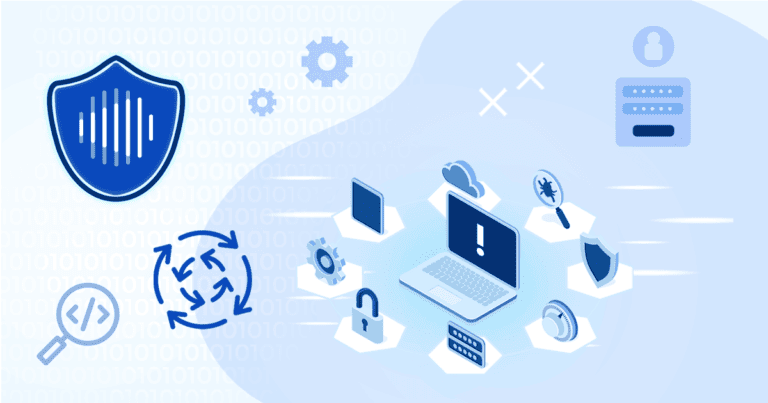Four features of modern AppSec that help curb cybersecurity burnout
In the race to innovation, security is often the victim of difficult time-saving decisions. Those decisions (or lack thereof) cause unnecessary stress for DevSecOps teams working to build secure, innovative applications as they’re forced to either skip critical security steps and deal with the headaches later on, or manually work through issues and delay deadlines. As cyberattacks and breaches pick up pace, modernizing your approach to AppSec can help relieve some of the stress that’s causing burnout in cybersecurity – and improve your risk posture in the process.
Your Information will be kept private.
Begin your DAST-first AppSec journey today.
Request a demo
We’ve got a burnout problem in cybersecurity. Like many in the industry, DevSecOps professionals are feeling the heat from a seemingly endless barrage of threats served up by bad actors day after day. Without the right tools and processes in place, that stress takes a toll.
If you don’t think it’s an issue that’ll impact your organization, just take a peek at the trends: according to 70% of Information Systems Security Association (ISSA) members, the cybersecurity skills gap has indeed impacted their companies. And with over 4 million unfilled cybersecurity jobs floating around out there, it’s clear that many organizations are having trouble finding and retaining talent, suffering the consequences of burnout.
At the same time, threats and breaches with serious consequences simply aren’t slowing down. The FBI’s Internet Crime Complaint Center (IC3) fielded a 7% increase in complaints between 2020 and 2021. According to Verizon’s Data Breach Investigations Report, the cybersecurity industry saw a 13% increase in ransomware breaches last year alone – that’s more than all previous five years combined.
As the exploitation of software vulnerabilities remains one of the “…top three initial infection vectors for ransomware incidents” reported by the IC3, it’s critical that organizations equip DevSecOps teams with the tools they need to build and maintain secure software – without compromising on security or sacrificing sanity. Here’s how to get it done.
Automation: it’s vital for speeding up DevSecOps
In web application development, subpar security or antiquated tools can create manual work or rework for DevSecOps professionals. That’s where automation shines, handling those more tedious security processes. When paired together, dynamic application security testing (DAST) and interactive application security testing (IAST) cut back on as much manual work as possible through the automatic discovery and scanning of all applications in development and production. Teams can build comprehensive, quick security testing right into the software development lifecycle (SDLC) with automated scans triggered in continuous integration/continuous delivery environments (CI/CD) or scheduled to test apps in production.
It’s about more than just fortifying security processes in the SDLC; automated vulnerability confirmation enables teams to remediate issues quickly and confidently, freeing up valuable time for security and development professionals so that they can focus on more high-value initiatives.
We know from recent research that DevSecOps professionals take pride in their work when they’re given the right tools and environments to thrive – 94% of respondents to our survey said that digital transformation and the recent shift to remote work has made their roles more valuable and rewarding. Wrapping automated security features into that digital transformation is bound to have lasting, positive effects on bandwidth and can help keep talented cybersecurity workers in their seats.
Accuracy: it takes the guesswork out of cybersecurity
Automation is a foundational feature in AppSec that helps accuracy stand tall. And, when in sync with more streamlined workflows, accurate automation is the only way to effectively bridge the cybersecurity skills gap. It gets you there by taking the guesswork out of security, boosting confidence for hands-on practitioners. When DevSecOps teams are assured that their scans and security findings are accurate, effectively automating routine operations becomes more of a reality.
Part of the accuracy equation is about reducing false positives. False positives are the annoying fruit flies that just won’t stop buzzing your buffet of code. They often stem from weak AppSec tools or a lack of mature processes, but regardless of where they come from, they’re a common headache that can stifle agility. Features like Proof-Based Scanning from Invicti – which confirms over 94% of direct-impact vulnerabilities with 99.98% accuracy – can help teams save time by automating critical manual steps with unbeatable accuracy. Ultimately, enterprise organizations can save hundreds of hours every single month and pump them back into software innovation.
Asset discovery: it helps uncover security blindspots
A lot of times, your most vulnerable web assets, components, and APIs are the ones you don’t even know exist. Organizations can generate hundreds and sometimes thousands of apps and websites, each with its own dependencies through often-outsourced code that hasn’t been checked internally by anyone at all. Asset discovery is a key component of a good AppSec program for that very reason; it helps you uncover those security blind spots that add to risk and contribute to existing security debt.
Security blind spots and debt are stressors for DevSecOps teams, muddying the prioritization waters and increasing anxiety. We know from our research that 81% of developers and security professionals are anxious about the next looming vulnerability always or right after the discovery of a new flaw. But with continuous web asset discovery baked into security processes, teams automatically uncover at-risk websites, web services, APIs, and apps for a clearer picture. That information becomes crucial to maintaining a complete web inventory so that assets don’t slip under the security radar.
Continuous coverage: it boosts DevSecOps confidence
Accuracy, automation, and asset discovery are must-have features for your AppSec program. But that coverage needs to be continuous and reliable too, generating accurate scan results that DevSecOps teams can use confidently when making decisions about security. And because what’s secure today might not be secure tomorrow, implementing continuous security coverage helps businesses stay one step ahead of those ever-evolving attack methods and the bad guys looking to exploit them.
Keep pace with these modern threats by ensuring that your team has scalable, automated, consistent security coverage in place, and that your AppSec program can change as business needs evolve in cybersecurity. If your program is flexible enough to adapt to these emerging threats, it’ll relieve unnecessary stress from the shoulders of your talented developers and security professionals so that they can dedicate more time and resources to innovation.
For a deep dive into workplace burnout and the impact it has on cybersecurity, check out the chat below between our Chief Product Officer Sonali Shah and Security Weekly on harmonizing DevSecOps to curb burnout:




